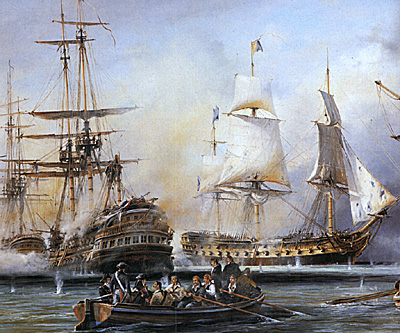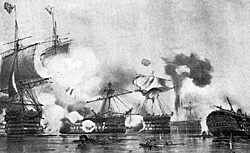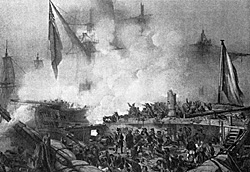More French Successes and British Frustration
 After Bonaparte took Malta in a bloodless invasion, he left a garrison and the armada sailed on.
After Bonaparte took Malta in a bloodless invasion, he left a garrison and the armada sailed on.
Robert Taylor's dramatic painting of "The Battle of the Nile" shows the action around 6:00 p.m. at the start of the battle on 1 August. The British ship Goliath (far left) fires a broadside into Conquerant. French sailors are attempting to return to their ships
in the foreground while Nelson's flagship Vanguard (center) moves down the French line. Reprinted with permission of The Military Gallery, Ojai, California..
On 1 August, 1798, a few minutes before 1:00 p.m., the advancing ships of Nelson's fleet
discovered the French fleet anchored in Aboukir Bay. The first shots, in what was to become known in England as the Battle of the Nile, were not fired until 6:20 p.m., over five hours later. By morning, thirteen of seventeen French warships would be captured or destroyed by the smaller British force. No British ships were lost, although several would be dismasted and suffer heavy casualties. At the time, it was the most crushing defeat ever suffered by French naval forces, and the greatest naval victory ever achieved by Britain. Why were the results so one-sided?
Problems plagued Vice Admiral Brueys from the moment the British fleet was sighted. Short of food and water, Brueys had sent substantial numbers of men ashore to collect supplies. Upon sighting the British fleet, Brueys signalled for the return of the shore parties. For a variety of reasons, that signal was not obeyed, and most of the ships (except for those in the
center) were each deprived of about 200 men when the fighting began. To compensate, Brueys moved sailors from the frigates and smaller ships to the thirteen larger warships anchored
in line. Because there were not enough sailors to both maneuver the French ships and man the guns at the same time, the decision was made to fight the fleet as it was anchored.
Later on, Brueys ordered each ship to send a cable to the ship next astern and to rig springs on their anchors to increase their manueverability while moored. Many ships failed to take
these precautions. Most ships were initially prepared to receive the British only on the seaward side of their line.
In spite of these problems, Brueys believed that time was on his side. With night coming on, and the approach to the bay protected by shoals, Brueys thought that the British would wait for
morning rather than risk a night battle in such dangerous waters. Brueys might have been correct if he had been facing anyone other than Nelson.
Nelson, having impatiently searched so long for the French fleet, had no intention of waiting until morning to begin the attack. At 3:00 p.m., Nelson signalled to prepare for battle. At 4:00
p.m., the British ships were instructed to anchor by the stern during the battle. This step prevented the ships from swinging when the anchor was dropped, exposing the ship to a possible
raking broadside. By anchoring at the stern, each ship could stop its forward motion opposite an enemy ship without swinging, and be in position to immediately begin firing broadsides into the enemy.
The British fleet advanced under full sails with a good wind from the northwest. Nelson's plan was so simple that he later was able to explain it to Admiral of the Fleet Lord Howe in under thirty words: "By attacking the enemy's van and centre, the wind blowing directly along their Line, I was enabled to throw what fire I pleased onto a few ships."
Captain Thomas Foley of the Goliath led the fourteen British ships of the line in to the bay. Using a map which proved accurate, Foley decided to pass the bow of the van French
ship, the Guerrier, to the landward side of the French line. As Foley believed, the French were unprepared on the landward side. Foley was followed by Zealous, Audacious, Orion, and Theseus. These ships each delivered a raking broadside into the Guerrier as they passed her bow, crippling the French 74 gunner. French ships further down the line held their fire, waiting for the British ships to anchor and swing, and paid dearly for their mistake. Anchoring by the stern, the British ships fired immediately after dropping anchor, dismounting or disabling many of their opponents guns in the first few broadsides.
... the combatants on both sides
demonstrated remarkable acts
of individual heroism.
The next five British ships were led by Nelson in the Vanguard along the seaward side of the van and center of the French line. This enabled them to catch the French ships in a cross-fire, which also undoubtedly caused some "friendly-fire" casualties among the British. The British ships sought to avoid this problem by anchoring at the bow or stern of a French ship where they could fire punishing raking broadsides into one or two French ships. In this position, French gunners were unable to bring most of their guns to bear against the British.
Culloden, towing a captured prize loaded with wine, entered the bay with the remaining two British battleships and the smaller Leander, but stuck fast on a reef and remained there throughout the battle, assisted by the brig Mutine. The remaining ships avoided the reef, and joined the battle. Nelson's effective forces were thus reduced to thirteen ships, one of which, the Leander, was an obsolete 50-gun ship.
 During the ensuing battle, the combatants on both sides demonstrated remarkable acts of individual heroism. Admiral Brueys, on board the flagship Orient, remained on deck although wounded twice, until around 7:30 when he was virtually cut in half by a shot
that tore off his left leg. Even still, he remained on the bridge, maintaining his
calm and heroic demeanor until the very end. In the meantime, Captain Casabianca and the crew of the Orient proved their mettle, managing to cripple the Bellerophon. Perhaps the most decisive moment of the battle came at approximately 10:00 p.m. - the Orient
caught fire and exploded in a horrific blast. J. Christopher Herold wrote:
During the ensuing battle, the combatants on both sides demonstrated remarkable acts of individual heroism. Admiral Brueys, on board the flagship Orient, remained on deck although wounded twice, until around 7:30 when he was virtually cut in half by a shot
that tore off his left leg. Even still, he remained on the bridge, maintaining his
calm and heroic demeanor until the very end. In the meantime, Captain Casabianca and the crew of the Orient proved their mettle, managing to cripple the Bellerophon. Perhaps the most decisive moment of the battle came at approximately 10:00 p.m. - the Orient
caught fire and exploded in a horrific blast. J. Christopher Herold wrote:
- "The concussion was felt in a twenty-five mile radius; the flash lit up Alexandria and Rosetta. Whole sections of the ship, masts, spars and riggings, flew sky high, mingled with human bodies, and came down in a flaming shower. The blast was succeeded by sudden silence: all the guns, British as well as French, ceased firing for at least ten minutes.
The crew of the Theseus tried a cheer, but it stuck in their throats. As the carcass of L' Orient sank to the bottom, the men who were still in the water were pulled down with it."
The battle never attained the same intensity as before. Prior to the explosion, in nearly four hours of fighting, no French ships had struck their colors. Even after the explosion of the Orient, and the surrenders of the Conquerant and Guerrier, the two opposing fleets were closely matched. The Bellerophon was heavily damaged and out of the battle, and the Culloden had run aground, leaving the British with twelve ships of the line, including the small Leander. Against them, the French still had ten ships of the line and four frigates.
 Here Admiral Villeneuve's passivity must come under scrutiny. He commanded the French rear, consisting of at least three ships of the line which had not yet engaged. Some critics contend
-- Napoleon foremost among them -- that had Villeneuve joined the battle, the outcome
still might have been a draw, if not a French victory.
Here Admiral Villeneuve's passivity must come under scrutiny. He commanded the French rear, consisting of at least three ships of the line which had not yet engaged. Some critics contend
-- Napoleon foremost among them -- that had Villeneuve joined the battle, the outcome
still might have been a draw, if not a French victory.
"Nelson owed his victory to the ineptness and the negligence of the captains of Le Guerrier and Le Conquerant, to the accident of L'Orient, and the poor conduct of Admiral Villeneuve .... It was in Villeneuve's power to turn the battle into a French victory as late as daybreak."
... had Villeneuve joined the
battle, the outcome still might
have been a draw, if not a French victory.
On the first night the British continued to pound the French line. At 3:00 a.m. on 2 August there was another lull in the battle and around 4:00 a.m. Nelson sent Lt. Capel out to the least damaged British ships to urge their captains to move down the line and engage the undamaged French ships (some of the them were already moving that way). Just after sunrise around 5:00 a.m. Heureux struck her colors and surrendered.
By morning, the center and van of the French line was in the possession of the British. The ships in the rear, however, were undamaged. When dawn arrived, Rear Admiral Villeneuve ordered the remaining ships to flee. The Genereux, Guillaume Tell, and two French frigates succeeded in reaching the entrance to the bay, although intercepted and fired upon by Zealous. Nelson, exhausted by the battle and sickened by a wound over his eye that had briefly incapacitated him, recalled Zealous allowing the French ships to escape.
The crew of the Timoleon set
her on fire with colors flying
and made for shore; the ship
blew up late in the morning.
This decision was to cost Nelson dearly. Two weeks later, the Genereux would intercept Leander carrying Nelson's dispatches home to England. Genereux exacted her vengeance for the French defeat at the Battle of the Nile. In a short and vicious battle, the outgunned Leander suffered considerably more casualties than at the Battle of the Nile, and was overwhelmed and captured.
After the escape of the four French ships exhaustion set in. In the afternoon of 2 August, a British boat rowed out to Tonnant to determine if they had struck, and were sent packing. Timoleon and Tonnant held out the rest of the day. On the morning of 3 August, Nelson sent some of the British ships to deal with the two remaining holdouts. The Tonnant finally surrendered. The crew of the Timoleon set her on fire with colors flying and made for shore; the ship blew up late in the morning. The two-day battle was officially over.
Of the British ships damaged at the Battle of the Nile, the Culloden was the worst off, as she severely damaged her hull upon the reef. She was kept afloat by extreme effort until she could be sailed to Naples where the hull was repaired. While her hull was damaged, Culloden's rigging was intact, and her spare masts were put to good use in repairing the damaged rigging of the other British ships.
Majestic and Bellerophon were completely dismasted. Alexander lost her topmasts. Vanguard's rigging was intact, although damaged. (Nelson had fought with the Spartiate at close range, so few of the French shot had reached the rigging, although they tried). Goliath's rigging was damaged but still standing. Midshipman Elliot reported that the main mast had 24 large shot through it, besides a quantity of grape, all above the quarterdeck. The mizzenmast was even more damaged, being cut more than half way through in one place. Goliath did such a good job in repairing its masts from its spars and timber that they lasted for more than 18 months until the ship reached England. Most of the other British ships had more or less similar damage. Mutine was the only British ship completely undamaged, having been occupied in attempting to get the Culloden off the reef during the battle.
The destruction of Brueys fleet left the British in control of the Mediterranean. In a single blow Nelson had ruined Napoleon's plans and marooned the French army in Egypt.
Historian Herold wrote:
- "Nelson attacked Brueys at Abukir Bay recklessly and became the hero of Europe overnight."
Although decisive campaigns were still in the future for Napoleon, his Egyptian adventure can not be counted among them. Surrounded by a hostile population, cut off from supplies and reinforcements, the French expedition was ultimately doomed to failure.
Jean Lochet, senior historian for Napoleon journal, translated French sources for this article. Virginia Medlen, a director in the Napoleonic Alliance, researched British primary sources for a planned book on the Battle of the Nile. Research assistance was also provided by Doug Ferguson, and all their material was blended for this feature.
More Battle of the Nile 1798
-
Battle of the Nile 1798: Introduction
Battle of the Nile 1798: French and British Navies
Battle of the Nile 1798: French Luck and British Pursuit
Battle of the Nile 1798: French Success and British Frustration
Battle of the Nile 1798: Battle of Aboukir Bay
Battle of the Nile 1798: British Campaign Medal
Battle of the Nile 1798: French and British Order of Battle
Battle of the Nile 1798: Large Voyage and Pursuit Maps (very slow: 386K)
Battle of the Nile 1798: Large Battle Maps (very slow: 336K)
Battle of the Nile 1798: Jumbo Battle Maps (extremely slow: 562K)
Back to Table of Contents -- Napoleon #13
Back to Napoleon List of Issues
Back to MagWeb Master Magazine List
© Copyright 1998 by Napoleon LLC.
This article appears in MagWeb (Magazine Web) on the Internet World Wide Web.
The full text and graphics from other military history magazines and gaming magazines are available at http://www.magweb.com
Order Napoleon magazine direct